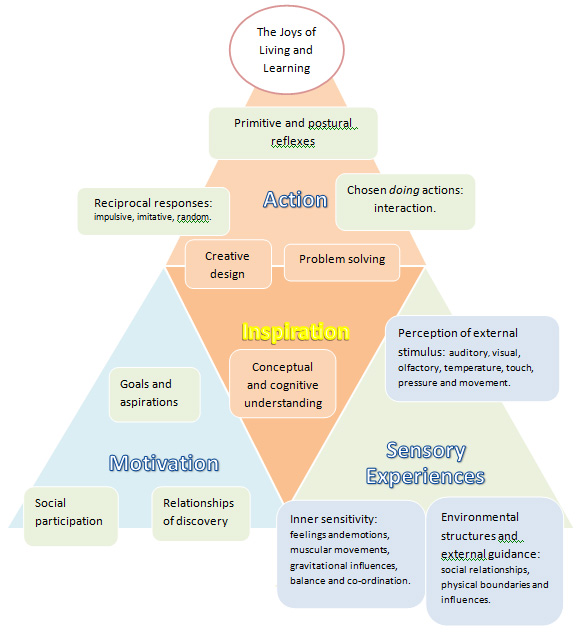Celebrating the mind – body – spirit potential through natural play and learning, art and design, creative expression, poetry and prose, sharing and caring.
 Creativity is the gift of movement Joy is the gift of love Happiness is the gift of being present
Creativity is the gift of movement Joy is the gift of love Happiness is the gift of being present
Peace is the gift of calm contemplation Gratitude is the gift of sharing Devotion is the gift of life
Reverence is the gift of humility Patience is the gift of time
Our materially rich world of object – bound entertainment holds ourselves and our children from natural creative occupation; no longer do we take time to spontaneously celebrate or authentically communicate or express genuine gratitude – these things cannot be bought as a prepack package of convenience. Our easy life of robots and machinery, our world of electric slaves and power struggles, distract us from playing with the flowers, listening to the birds and rolling on the grass. Without these freedoms and spontaneity, where does the inspirational flow of creativity find its source? When does the heart burst into songs of communication that overflows into a space of natural play and learning?
Through creative activity we can facilitate personal expression, social interaction, and spiritual growth. Creative games and activity by their very nature do not have a pre-determined measure of success.
Detailed and accurate sensory information is essential for learning through discovery and imitation. When sensory information illustrates detailed and associated structural information, within a conceptual context of communication, the learner can gain a broader and more detailed understanding.
Sensory information is paramount to all learning but the depth of human potential goes far beyond integration within the physical sensory system. Human potential embraces feelings, imaginative thoughts, conceptual understanding and multi-levels of consciousness. This gives our learning the added potential to go beyond that of imitation or simple copying.
‘In other words, you must see why everything that awakens intense interest in children also helps strengthen their memory. We must increase the power of memory through the feeling and will and not through simple intellectual memory exercises.’ (The Foundations of Human experience, Steiner 1996:page137)
Interactive games and creative activities motivate learning through social interaction and multisensory aesthetic experience. Thus individual and unique creative variations are held within the boundaries required for mastery of desired and required skills. Creative expression is directed as a unique moment by moment interaction. Many aspects of exploration that might otherwise be defined as failure become windows of learning and encouragement. The celebration is thus experienced in the doing and the sharing rather than competitive levels of academic achievement. Through creativity we embrace the universal love that sanctifies faith and units us within the grace of joy and peace.
Creativity is born from heart magic – when ideas, feelings and experiences flow togerther like the water in the stream; where an infinite freedom is contanined within the boundaryies of the geographical terain and the earthly laws of physics.
Multisensory learning is fundamental to the integration of creativity, aesthetic appreciation and divergent thinking. The deeper the understanding through open ended learning the more opportunity the learner has to transfer the learning appropriately into other situations.
The true art of teaching is to creatively present multisensory information through an integrated spectrum of accurate conceptual communication. The true master successfully supports others to discover for themselves what s/he can already do with natural ease, genuine understanding, authentic passion and notable attention to small detail.
Maria Montessori pioneered didactic (intending to teach) apparatus that promotes sensory-motor activities and develops skills of differentiation related to colour, 2D and 3D shape, sound and smell. Montessori methods place a particular emphasis upon the importance of training the child to isolate, refine, improve, and make sense of specified areas of sensory perception and discrimination.

Eastwood Education approaches learning through multi-sensory integration as a basis for discovery learning and conceptual understanding. Through our senses we recognise elements of our world that support inner assessment and judgement.
This approach to multi-sensory learning requires environmental scaffolding that inspires:-
- a broad spectrum of creativity and aesthetic appreciation,
- development and mastery of skills,
- self-correction,
- co-operative interaction and internal self-discipline.
‘….thus you can now comprehend judging as a living bodily process that arises because your senses present you with a world analysed into parts…..Here the act of judgement becomes an expression of your entire human being.’ (The Foundations of Human experience, Steiner 1996:page144-145)
When consciously looking at our reactions and interactions we can consider all aspects of our lifeas part of our way forward to higher levels of learning and consciousness. We can thereby acknowledge a sense of greater responsibility for what and how we experience what we bring towards ourselves, and what interaction we chose to follow.
Steiner presented that before the change of teeth the young child is ‘essentially an ensouled sense organ entirely given over in a bodily religious way to what comes towards it from the surrounding world’ and that sensory experience ‘permeates the child’s entire organism.’ He suggests that whatever is happening in the child’s environment is wholly and subconsciously received by his senses and thereby also affects his soul and spiritual development. [Steiner, R. The Child’s Changing Consciousness, Anthroposophic Press; New York, 1988: pages 40&75)]
